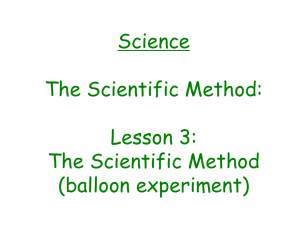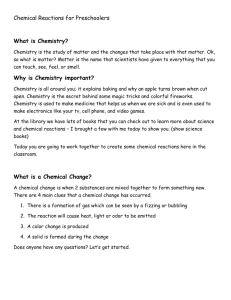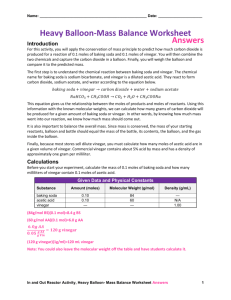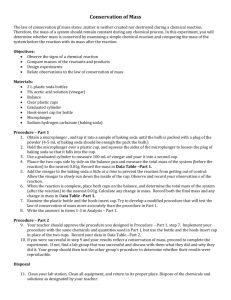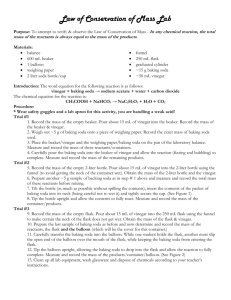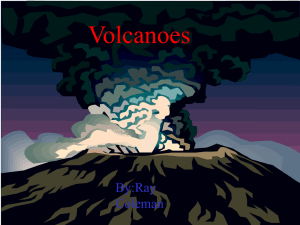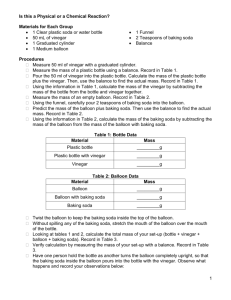Lab 6 - Christian Victory Academy
advertisement
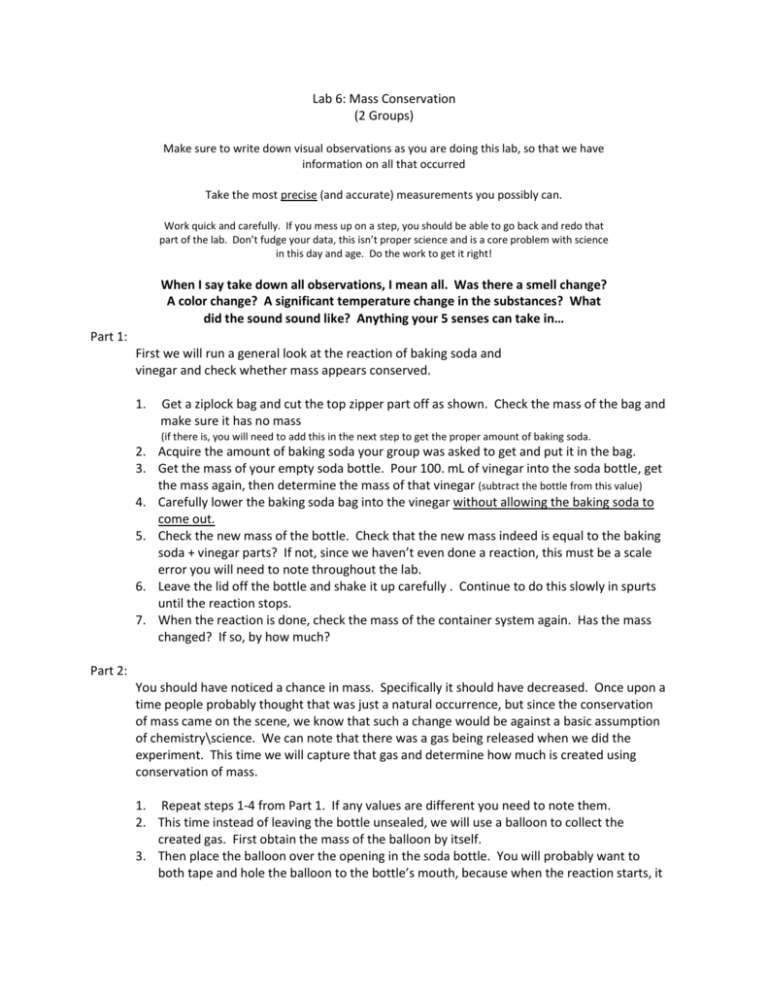
Lab 6: Mass Conservation (2 Groups) Make sure to write down visual observations as you are doing this lab, so that we have information on all that occurred Take the most precise (and accurate) measurements you possibly can. Work quick and carefully. If you mess up on a step, you should be able to go back and redo that part of the lab. Don’t fudge your data, this isn’t proper science and is a core problem with science in this day and age. Do the work to get it right! When I say take down all observations, I mean all. Was there a smell change? A color change? A significant temperature change in the substances? What did the sound sound like? Anything your 5 senses can take in… Part 1: First we will run a general look at the reaction of baking soda and vinegar and check whether mass appears conserved. 1. Get a ziplock bag and cut the top zipper part off as shown. Check the mass of the bag and make sure it has no mass (if there is, you will need to add this in the next step to get the proper amount of baking soda. 2. Acquire the amount of baking soda your group was asked to get and put it in the bag. 3. Get the mass of your empty soda bottle. Pour 100. mL of vinegar into the soda bottle, get the mass again, then determine the mass of that vinegar (subtract the bottle from this value) 4. Carefully lower the baking soda bag into the vinegar without allowing the baking soda to come out. 5. Check the new mass of the bottle. Check that the new mass indeed is equal to the baking soda + vinegar parts? If not, since we haven’t even done a reaction, this must be a scale error you will need to note throughout the lab. 6. Leave the lid off the bottle and shake it up carefully . Continue to do this slowly in spurts until the reaction stops. 7. When the reaction is done, check the mass of the container system again. Has the mass changed? If so, by how much? Part 2: You should have noticed a chance in mass. Specifically it should have decreased. Once upon a time people probably thought that was just a natural occurrence, but since the conservation of mass came on the scene, we know that such a change would be against a basic assumption of chemistry\science. We can note that there was a gas being released when we did the experiment. This time we will capture that gas and determine how much is created using conservation of mass. 1. Repeat steps 1-4 from Part 1. If any values are different you need to note them. 2. This time instead of leaving the bottle unsealed, we will use a balloon to collect the created gas. First obtain the mass of the balloon by itself. 3. Then place the balloon over the opening in the soda bottle. You will probably want to both tape and hole the balloon to the bottle’s mouth, because when the reaction starts, it will put a lot of temporary pressure on the balloon, and if you aren’t careful it will push it if off. 4. While this is happening, we will also need to look at how big the balloon gets. One person in the lab should determine how wide the balloon gets. You will want to note half of the new width as this is the new radius of the balloon (which you will use in the homework). Use a ruler and measure this in cm as it goes. Try to obtain the largest value of the balloon during the reaction. 5. Now that you have the balloon on and everything massed, you can do the reaction. Do it as before, but remember, it is vital the balloon remains tight on the bottle. 6. When you are done, you may release the balloon, but do not empty out the bottle or tip it up at a large angle. You will need it as it is for part 3. Typically when making a recipe, you have extra of some ingredients and not enough of others. The ingredient that runs out first is called the “limiting reactant”. To find out what ran out first in our reaction, we can add some more of one of the ingredients. Add more baking soda. If the reaction starts going again, the “limiting reactant” was the baking soda. If nothing happens, then you ran out of vinegar. Made sure to note the limiting reactant In this lab, the reaction was baking soda + vinegar makes carbon dioxide + water + a different complex dissolved solid Extra Part 3: Comparing Carbon Dioxide to Air – You have produced carbon dioxide in this lab. Let’s look at one neat property of carbon dioxide… it is heavier than air…. Since carbon dioxide formed in the bottle, as long as you didn’t tip it up, the heavier nature of it should have forced most of it to stay in the bottle. 1. Have one team member light a candle and hold it. 2. Slowly tip the bottle to near horizontal. Make a motion like you would if the bottle were ¾ full and being poured onto the candle. 3. Note what happens. If you have issues, you may need to redo the reaction or get help. Additional results to find for Lab 2: Determine the mass of carbon dioxide produced. To do this, you would use the conservation: (Mass vinegar beforehand) + (Mass baking soda before hand) = (Mass of solids and liquids produced) + (Mass CO2 gas) You know all values except the mass of gas, so solve for it in the equation above. When the balloon blows up, we could use this to accomplish tasks. If we look at this further, there is both a change in volume for the balloon and a force that does the pushing of the balloon outwards. This indicates that work is being done! With a little physics manipulation, our work equation we have used can be altered to consider this problem…. Work = (Force) × (Distance) = (Pressure) × (Change in Volume) This should seem reasonable since it is harder (takes more work) to blow up a balloon when there is more pressure preventing you from blowing it up. It also takes more total work to blow the balloon up larger. We will talk more about pressure later in the year. For the time being, will use a simplified version of this equation assuming typical conditions: Work = 101.3 Joules/Liter × (Change in Volume) Calculate the work done in this chemical reaction. (assume that original balloon volume was nothing… 0 L… before the reaction) (to find the final volume, remember that the volume of a sphere [which we will assume a balloon is] is 4/3πr 3. So if you properly measured how big the balloons radius was, you can plug it in and get the final volume) An electric toothbrush uses 7 Watts of power. This is 1 Joule each second. Caclulate how many seconds your baking soda reaction would be able to power the toothbrush for. Questions for Lab 6: 1. What sources of error could have caused our calculated amount of CO2 to be incorrect? 2. Think about the difference in the gases we learned about in this lab. In the event of a building fire, burnable “fuel” reacts with oxygen and creates smoke (carbon dioxide). Do you think that crawling in a fire is a good choice? Why or why not? Energy must be conserved. Often in reactions that accomplish work, the energy was stored up in the bonds making up the compound. However… neither baking soda nor vinegar is a substance we typically think of as being volatile or having much energy (we don’t use them for fuel!). If you made careful observations in the lab, you may have noted an important change that explains the energy balance. 3. Regardless, theorize on how the energy changes are balanced for the reaction.

